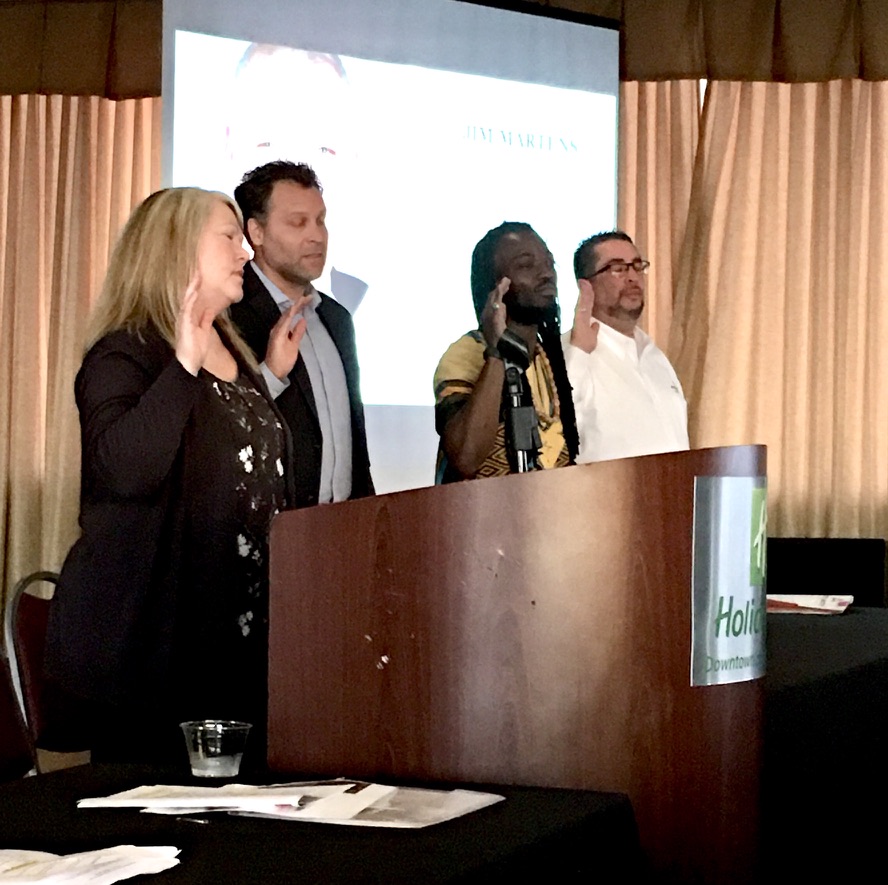Earlier this week I spent three days with Affinity Credit Union. I was invited to speak at their Annual Members meeting. This would be my first live, in- person speech in years, to a credit union with which I had no prior connection.
I asked to come a day early to learn about why this $140 million, 74-year state charter in Des Moines, IA wanted me to speak. The CEO’s response was simple: I want you to see what we do. In other words, for me to learn.
I accepted. In later posts I will share some of the things I experienced. But one event was totally unique. I had never seen it in my 45+ years with credit unions. It is an example that other credit unions should consider.
The OATH
The members’ meeting began at 5:30 with a buffet dinner for the over 200 people in attendance. The agenda was long running, from “A” to “Q” in the outline given with the Annual Report. There were three speeches by outside guests (I was one), six high school scholarships presented, recognition of three employees who had passed twenty-five years each in service all before the business portion of the meeting.
At the conclusion of the business meeting, the Chair Cindi asked all the newly elected and continuing directors to stand for their oath of office. The oath was administered by a former chair and director. He read the phrases and they would repeat together following him.
The oath begins with the words “do solemnly swear” and included the following commitments:
I will diligently, faithfully honestly and impartially perform the duties imposed upon me by the bylaws
I will not knowingly violate. . .any of their provisions
I further swear that I will. . .properly discharge the duties of any office or committee to which . . .I am appointed
I will not discuss the affairs of this credit union or any of its members wit anyone except credit union officials
I will give all possible assistance to any person who may succeed to any office which may hold. .
The nine directors stood together at the front of the room, hands raised, repeating the oath in unison before their families, friends and hundreds of members and guests. An important and solemn moment of a public commitment to their fellow owners and community.
The Oath’s Origins
As I had never heard about this happening in credit unions, I asked how it became a part of the Annual Meeting. Was it required in the bylaws? By their state charter? By some other tradition?
The practice had been followed long before the current leadership team was in place. Even prior to the former director and chair who administered the oath this year. He recounted:
It was given long before I got on the board. I was told that it was because it was swearing an oath to the local 310 members (the credit union’s original union chartering group at the Firestone plant) that they would take care of the credit union when it was members and family only. Local 310 still swears an oath to protect our brothers and sisters to respect and do no harm with actions or pen.
Unfortunately, in today’s environment not every union member thinks it’s necessary to swear an oath to watch out for each other. So it probably goes all the way back to the lunch box (when the credit union was chartered in 1947.) That lunchbox symbolizes a resource created by workers, for workers, that feeds families, futures and trust.
A Vital Example for Cooperatives
Vows, oaths or formal swearing ins are rare in organizations today. Perhaps when joining a church (statement of belief) or wedding vows or perhaps a pledge such as when joining the Boy Scouts.
There is however one universal practice where an oath is administered, when a person joins the military or becomes a federal employee. The constitution requires the practice as explained in this article:
The reason is simple – public servants are just that – servants of the people. After much debate about an Oath, the framers of the U. S. Constitution included the requirement to take an Oath of Office in the Constitution itself. Article VI of the Constitution says, “The Senators and Representatives before mentioned, and the Members of the several State Legislatures, and all executive and judicial Officers, both of the United States and of the several States, shall be bound by Oath or Affirmation, to support this Constitution . . .;
The author states the intent: One purpose of the Oath of Office is to remind federal workers that they do not swear allegiance to a supervisor, an agency, a political appointee, or even to the President. The oath is to support and defend the U.S. Constitution and faithfully execute your duties. The intent is to protect the public from a government that might fall victim to political whims.
Should Credit Union Directors Swear an Oath?
As volunteers, directors are often seen as an eleemosynary activity, an act of charity. Therefore the demands of a director should not be the same as in a formal, paid position of responsibility.
This characterization is even noted in federal legislation as recently as the Membership Access Act in 1998. In setting the new PCA reserve requirements, the legislation directed that the NCUA consider the volunteer nature of credit union leadership when imposing capital standards.
I believe that an annual oath taking in front of members and community, would not only be good practice, but honor and enhance the tradition of credit union volunteer leadership. The requirement could be made a standard part of the bylaws, which is the governing document, as noted in the oath above.
As a public event following the business meeting, it formalizes their accountability to the members whose authority has elected them to their positions.
Most critically the oath taking represents a transparent commitment to one of the most important tenents of cooperative design: the democratic member voting process. It reaffirms the trust members expect and are properly owed by their elected directors.
If you would like to receive a full copy of the Affinity Oath, contact Kris Laufer at klaufer@affinitycuia.org.



